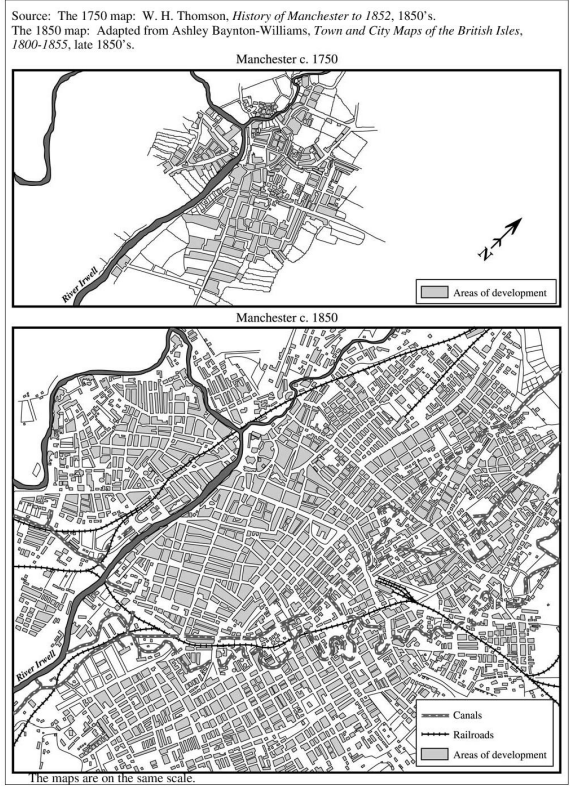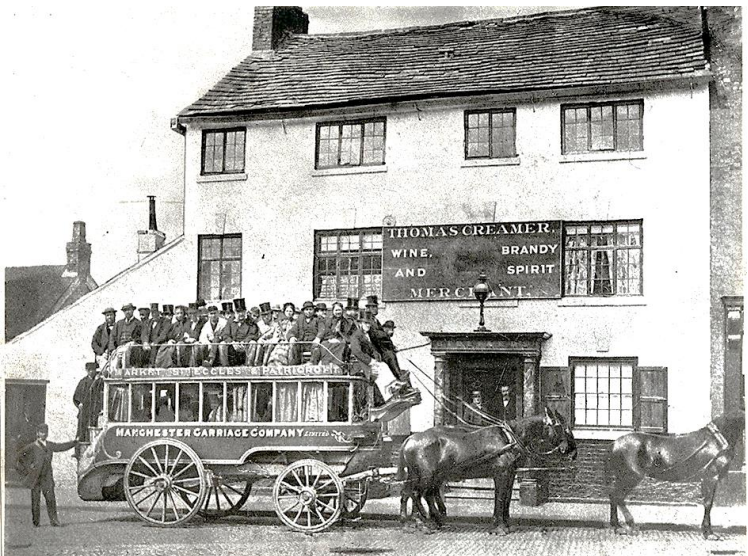Introduction
Contextualization Industrialization was one of the most influential periods in human history, introducing new manufacturing technologies and significantly changing the conventional way of life. The period from 1750 to 1871 can be classified as the First Industrial Revolution, and Manchester was the world center of the ongoing transformation. This period was pivotal in shifting from manual labor to machine manufacturing globally, but the changes were particularly noticeable in Manchester. During the Industrial Revolution, people from different parts of the country came to the city searching for work, hoping to improve their quality of life.
Thesis Before the Industrial Revolution, city life in Manchester and globally was completely different. The lack of machines and innovative technologies implied more focus on agriculture and manual labor. Consequently, there were no railways or trains, meaning that it was more challenging for people to travel across the country searching for better work opportunities. In summary, the daily life of an average English citizen before and during the Industrial Revolution was drastically different, and it is critical to examine these changes. Ultimately, the current paper argues that the general quality of life significantly improved in Manchester during the 1750-1871 period.
Roadmap First, by the end of industrialization, Manchester grew into a prospering city, accommodating approximately 400,000 people and providing multiple work opportunities for citizens across the country. Secondly, the industrialization period led to a significant increase in wages, particularly for people coming to Manchester from rural areas. Thirdly, Manchester became the center of innovations, including machine manufacturing and technologies emphasizing daily necessities, such as horse buses. Lastly, by the end of the Industrial Revolution, the overall quality of life significantly improved for most people, creating a notable middle class in Manchester.
Argumentation
Urban Infrastructure
The most noticeable change in Manchester during industrialization was the sheer increase in size, suggesting that people intentionally moved to the city searching for better work opportunities. Figure 1 below presents specific evidence in the form of a visual depiction of urban changes from 1750 to 1850.

This drastic transformation in city planning was necessary due to more people coming to Manchester and the increasing number of factories and other facilities that boosted local manufacturing. Additionally, the construction of railroads allowed people to travel from their homes to their workspaces significantly faster, increasing the time they could spend at home with their families. While this benefit was more noticeable by the end of the Industrial Revolution, Manchester continually improved its infrastructure to make the lives of people more convenient and pleasant. Ultimately, this change implied the enhancement of quality of life in the city in 1850-1871, compared to early stages of industrialization.
Impact of Increased Wages
Consequently, the earnings of a regular Manchester citizen significantly increased during industrialization. William Alexander Abram thoroughly described these changes, attributing the improved quality of life and increased wages to innovative machinery and technologies. He reported the enhancement of working conditions, including the convenience of the facilities and more tolerable working hours. Namely, Abram stated, “Wages — thanks mainly to accelerated machinery and improved working conditions — have largely increased”. To confirm the credibility of the quote, it is critical to analyze the source. The most significant argument in this breakdown is the context of the journal article – Abram wrote it in 1868 at the end of the historical period. By that time, the city was able to solve most of the problems that occurred in the early 19th century, stabilizing the balance between wages and quality of life. The author’s quote reflects the surrounding context, noting the differences between the working conditions in 1868 and 1800. These changes concern all areas of life during industrialization and demonstrate the connection between the quality of life and work.
Innovations and Quality of Life
The following argument concerns various innovations and their positive impact on the overall quality of life of people in Manchester. This position shows that urban planning emphasized not only machine manufacturing and improvements, but it also proposed new incentives that made the daily lives of regular citizens more convenient. For instance, the photograph by the Manchester Carriage Company illustrates a “horse bus” – a new type of carriage for transport (see Figure 2). Compared to previous iterations, this innovation allowed accommodating more people with additional comfort and increased the overall passenger load in the transport network. In turn, it meant that people could travel much faster from their homes to any point of interest, whether their workspace, restaurants, or music halls. This type of transportation closely resembles modern systems and can be considered a notable quality-of-life upgrade compared to transport before industrialization.

Additionally, CAPP analysis can reveal more valuable insights into the correlation between these innovations and the overall quality of life in Manchester. Namely, the foundation of the Manchester Carriage Company was a natural continuation of industrialization since people acquired more disposable income and had more leisure time. In other words, there was a notable demand for new ways of transportation so that people could access restaurants, libraries, and other points of interest with greater ease and comfort. Moreover, the city was growing rapidly in terms of location and population size, and it was inconvenient to keep using regular carriages. As a result, the examination of context at the end of the First Industrial Revolution transparently shows that people were living better than at the beginning of the 19th century. This change in the quality of life stimulated the implementation of new technologies that were beneficial for regular citizens.
Hardships during Mid-Industrialization
Nevertheless, despite the evident improvements in quality of life by the end of the historical period, it is critical to note that many people experienced hardships during the early 19th century in Manchester. This counterargument should be addressed to understand the dynamics and impact of industrialization on regular citizens throughout the whole period. Many journalists, politicians, and scientists expressed their concerns about the worsened working and living conditions, specifically during the early 19th century. For example, Robert Southey criticized Manchester’s urban infrastructure after visiting it in 1807. When the city was in the transition period from pre-industrialization to the industrialization system, many buildings were designed exclusively for practicality. Southey wrote, “The houses all built of brick and blackened with smoke <…> without their antiquity, without their beauty, without their holiness”. The author demonstrated disdain for innovative machinery, noting cultural degradation as an inevitable consequence of industrialization.
Although the current paper defends the position that the quality of life in Manchester improved during industrialization, the early 19th century was the darkest period regarding working conditions in the city. A French socialist, Flora Tristan, criticized this way of living and believed that it led to moral degradation. Moreover, she condemned urban planning and factory working conditions, stating, “the comfort and welfare of the workers have never entered the builder’s head.” Another prominent socialist who heavily criticized Manchester during industrialization was Friedrich Engels, known as one of the co-founders of Marxism. He explained how industrialization led to the neglect of family life and children, repeating the idea of other authors about moral and cultural degradation. Namely, Engels stated, “Can we expect that children growing up in this savage way, amidst these demoralizing influences, will turn out good in the end?” According to him, the working and living conditions were unacceptable during industrialization.
However, it is critical to examine the sources in greater detail to identify potential bias. A CAPP analysis with a focus on the point of view can reveal why the authors’ positions were exclusively negative on industrialization in Manchester. For instance, Engels’ criticism was partly based on personal experience – his father had a factory in Manchester. Since Engels was primarily discussing the negative impact of industrialization on family life and children, it is plausible to assume that he experienced this neglect firsthand and developed a bias. He grew up in a wealthy household but had no interest in continuing the family business. Moreover, his socialist perspectives were relatively radical at the time, even compared to other philosophers and social activists. These specificities in Engels’ point of view potentially make the source less credible and reliable since there was a significant personal bias.
Quality of Life Improvement
Lastly, it is essential to prove that the quality of life in Manchester improved during the industrialization period despite the drawbacks described by Engels and Tristan. The main argument is that Manchester became significantly richer by 1870 compared to its state in 1750. Moreover, the differences in numbers are extreme: for instance, Manchester and surrounding areas within 30 miles produced more than 40% of global cotton in 1900 (Mohajan, 2019). In 1750, it was a relatively small town, but a hundred years after, it prospered into the world center of textile production and industrialized manufacturing. The city grew immensely rich, and many people acquired extensive disposable income. As a result, the middle class expanded rapidly, with most citizens being able to afford comfortable living by the end of the industrialization period (Mohajan, 2019). It was the first time in history that such an extensive number of people without specific education or skill sets had high standards of living.
Living standards were rapidly improving during the industrialization period, and there is extensive evidence supporting this perspective. Mohajan (2019) lists such benefits as urbanization, business opportunities, new technologies, more accessible education, and better housing. Moreover, the Industrial Revolution narrowed the gap between men and women due to the shift from manual labor to automated systems that did not require significant physical strength. As a result, more women became self-sustaining with their own source of income, and this change was beneficial for women’s rights in society (Mohajan, 2019). This transformation occurred throughout the whole country, and Manchester was one of the leading cities during this era.
Complex Argument Nevertheless, this quality-of-life improvement is most noticeable during the 1850-1871 period. As Mohajan (2019) notes, “Growth and rates of productivity change only accelerated after 1850, when the classic period of the IR ends” (p. 13). This perspective aligns well with counterarguments by Engels and Tristan in the first half of the 19th century. Hence, the complex argument of the paper is that people experienced a slight decrease in the quality of life from 1800 to the late 1840s. However, the consequent acceleration of the Industrial Revolution, stabilization of work-life balance, and focus on new customer-oriented technologies significantly improved living conditions in Manchester. Ultimately, considering the whole period from 1750 to 1871, it is evident that a regular Manchester citizen experienced a drastic increase in quality of life and had access to more goods, services, and work opportunities.
Conclusion
The 1750-1871 period was pivotal in the history of Manchester as the city became the world center of industrialization. While some people experienced multiple hardships at the beginning of this era, the overall quality of life drastically improved by 1871. The emerged middle class had numerous work opportunities, disposable income, access to education, and multiple sources of entertainment. The work-life balance, compared to the early 19th century, significantly improved, and people could allocate more time to their families and loved ones. At the same time, new technologies and means of transport made daily lives more comfortable and convenient. In summary, Manchester transformed from a small town to one of the major urban centers globally, and the quality of life in the city during industrialization improved significantly.
Reference
Mohajan, H. (2019). The first industrial revolution: Creation of a new global human era. Journal of Social Sciences and Humanity, 5(4), 377-387.